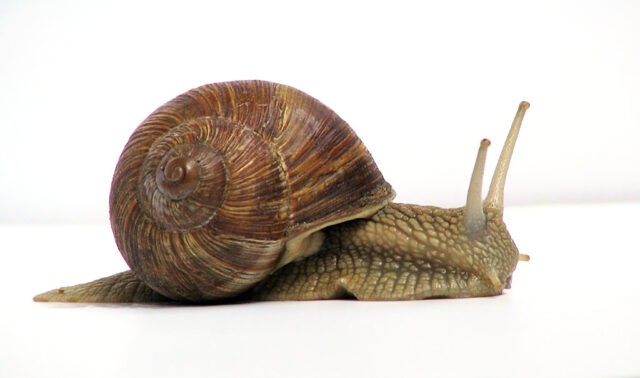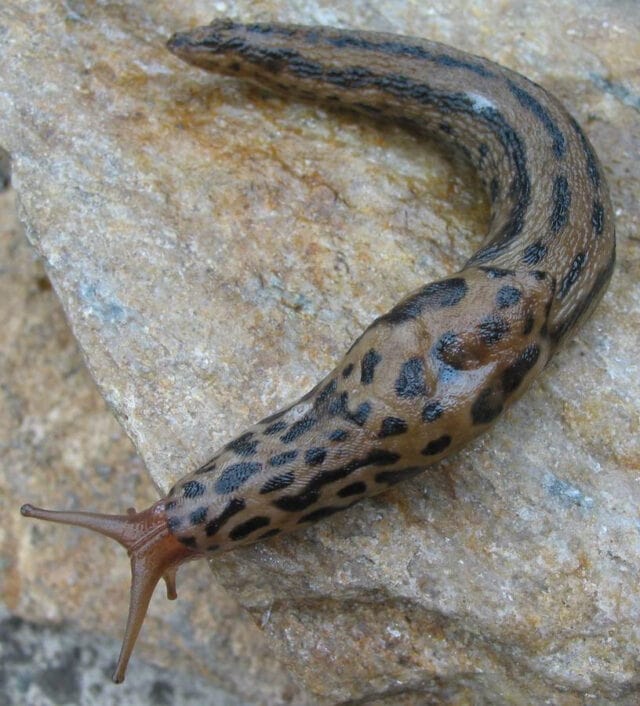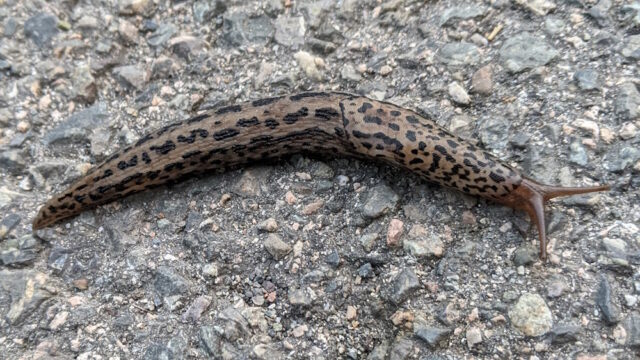Leopard geckos can eat slugs and snails, but with certain considerations. While these mollusks might seem like an interesting addition to their diet, it’s essential to understand their role, benefits, and potential risks.
Can Leopard Geckos Eat Slugs and Snails?
Yes, leopard geckos can consume slugs and snails, but it’s not as straightforward as it might seem. While both slugs and snails belong to the mollusk family, they have distinct differences. Slugs are essentially snails without shells, appearing more gelatinous and slimy. On the other hand, snails carry a coiled shell on their back, which can vary in size and pattern.
Slugs and Snails in the Diet of Leopard Geckos

Slugs and snails, while intriguing, don’t naturally play a significant role in the diet of leopard geckos. In the wild, leopard geckos primarily feed on a variety of insects, which are smaller and easier to digest. The size difference between slugs and the typical prey of leopard geckos is notable. Most insects that geckos consume are compact, allowing for easy ingestion and digestion. In contrast, slugs, especially larger ones, can be quite bulky.
Moreover, the nutritional profile of slugs and snails doesn’t align perfectly with what leopard geckos require for optimal health. While they can be consumed occasionally for variety, relying on them as a staple food isn’t recommended. Their consistency and potential for harboring parasites or toxins make them less than ideal as regular prey.
Types of Slugs and Snails That Are OK
While it’s clear that slugs and snails shouldn’t be the mainstay of a leopard gecko’s diet, certain types can be offered occasionally for variety. Each type has its own set of characteristics and nutritional benefits.
Leopard Slugs

Leopard Slugs, as their name suggests, are easily recognizable by their distinct striped pattern. This unique appearance sets them apart from many other slug varieties. While not a primary choice, they have been known to be a common food source for some leopard geckos, especially when other prey is scarce.
One of the reasons they might be considered as an occasional treat is their nutritional content. Leopard Slugs can be a beneficial source of calcium and protein for geckos. These nutrients are vital for the overall health, growth, and bone structure of the gecko. However, it’s essential to ensure that the slugs haven’t been exposed to pesticides or other harmful substances.
Land Snails
Land snails are another intriguing option when considering diverse food sources for Leopard Geckos. These mollusks come in various sizes and species, each with its own set of characteristics. Some common types that might be considered for geckos include the garden snail and the Roman snail, among others.
As a potential food source, land snails offer a different texture and taste, which can be a novel experience for your gecko. Nutritionally, they can be a good source of protein, calcium, and other essential minerals. However, like with slugs, it’s crucial to ensure that the snails haven’t been exposed to harmful chemicals or pesticides.
Other Types of Slugs and Snails
Diversifying the diet of Leopard Geckos can be an exciting endeavor, and there’s a range of slugs and snails to consider. Here’s a list of some that can be introduced to your gecko’s diet:
- Leopard Slugs: As previously mentioned, these are characterized by their unique striped pattern and can be a nutritious treat when given occasionally.
- Land Snails: These are versatile and come in various species, offering a good source of protein and calcium.
- Garden Slugs: Commonly found in many gardens, they are smaller in size and can be an easy treat for geckos. However, ensure they haven’t been exposed to pesticides.
- Banana Slugs: Recognizable by their bright yellow color, they are one of the largest slug species and might need to be portioned appropriately for your gecko.
- Field Slugs: Typically found in fields and meadows, they are another potential treat but, like garden slugs, should be sourced responsibly to avoid chemical exposure.
Benefits of Feeding Slugs and Snails to Leopard Geckos
Introducing slugs and snails into the diet of Leopard Geckos can offer more than just a change of taste. These mollusks bring with them a set of nutritional benefits that can contribute to the overall well-being of your gecko.
Source of Protein
Protein plays a pivotal role in the diet of Leopard Geckos, and slugs and snails can be a valuable source of this essential nutrient. The nutritional composition of these mollusks, especially their protein content, can significantly benefit the geckos’ overall health, ensuring robust growth and vitality.
Here are the top 5 key benefits of feeding slugs and snails to leopard geckos:
- Muscle Development: The protein from slugs and snails aids in the development and repair of muscles, ensuring your gecko remains strong and active.
- Enhanced Growth: Adequate protein intake is crucial for young geckos, helping them grow at a healthy rate.
- Energy Source: Protein provides a consistent energy source, keeping your gecko lively and alert.
- Supports Metabolism: Proper protein intake ensures efficient metabolic processes, aiding in digestion and nutrient absorption.
- Boosts Immune System: The nutritional composition of slugs and snails can strengthen the gecko’s immune system, helping fend off potential illnesses.
Variety in Diet
A varied diet is paramount for the health and well-being of Leopard Geckos. Just as humans thrive on a diverse range of foods, geckos too benefit from a mix of different prey items. This variety ensures they receive a broad spectrum of nutrients, preventing potential nutritional deficiencies that can arise from a monotonous diet.
Offering a diverse range of prey items, including slugs and snails, introduces different textures, tastes, and nutrients. This not only keeps mealtime interesting for your gecko but also provides a balanced intake of essential vitamins and minerals. Some potential prey items for a varied diet include:
- Insects: Such as crickets, mealworms, and roaches. Even some stink bugs could work.
- Worms: Like earthworms and waxworms (which turn into wax moths).
- Rodents: Small mice can be an occasional treat for adult geckos.
- Amphibians: Some geckos might also consume small amphibians, though this is less common and should be approached with caution.
To further enhance the nutritional value of these prey items, there’s the concept of gut-loading and dusting. Gut-loading involves feeding the prey nutritious foods before offering them to the gecko, ensuring they’re packed with beneficial nutrients. Dusting, on the other hand, involves lightly coating the prey with calcium and vitamin supplements, ensuring your gecko gets an extra boost of essential nutrients.
Potential Risks
While slugs and snails can offer nutritional benefits to Leopard Geckos, it’s essential to approach their inclusion in the diet with caution. Like all foods, there are potential risks associated with these mollusks that every gecko owner should be aware of.
Accidental Ingestion of Slug Pellets or Soapy Water
One of the significant risks associated with feeding slugs to Leopard Geckos is the accidental ingestion of harmful substances. Slugs often come into contact with slug pellets or soapy water, commonly used in gardens as deterrents or pest control methods. If a gecko consumes a slug that has ingested or been exposed to these substances, it can pose severe health risks.
Slug pellets and other chemicals designed to control slug populations can be extremely dangerous or even lethal if consumed by geckos. These substances are formulated to be toxic to pests, and their ingestion can lead to poisoning, causing a range of symptoms from mild discomfort to severe health complications or death.
Furthermore, slugs have a knack for picking up toxic substances from their environment, such as pesticides. Even if a garden doesn’t directly use slug pellets, pesticides used on plants can be just as harmful. When a gecko consumes a slug carrying these toxins, it indirectly ingests these harmful chemicals, posing a significant risk to its health.
